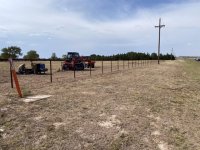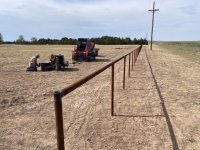oosik
Epic Contributor
The accuracy of the OP's GPS caught my attention also. Must be Trimble equipment. On a clear day, out in the open, my Garmin GPS is +/- ten feet, at best. However - that point being made - whatever works for you.
Yes we are using Trimble R10 RTK GPS.
It is a centimeter level accuracy unit. Not something recreational grade.
That's a very expensive piece of equipment - just to locate fence posts. I'm sure somebody had the equipment for other uses.
My property is a true rectangle. 80 acres - 1320 x 2640. Due to hill & gully terrain - never able to eyeball even the short sides. But we got the mile and a half of barbed wire fence in - +/- probably five feet. There were parts of the old homestead fence still in place - that helped a whole lot.
Out here everything is open range land. Nobody would get their knickers in a twist if a fence were installed without the use of sophisticated survey equipment.
We finished setting all the posts yesterday. Ended up using 8.5 pallets, or 360 80lb bags in three days. Today we start welding.
In my N. Tx. Houston Black Clay, they wiggle up out of the ground. You pour with the crete even...at ground level. A year later, after a season of going from mud to rock to mud, you find the crete is 1" above gnd level. Next year 2"...all the while the line T posts drop an inch per year with the cracks that occur in the dry months. Only thing that keeps them from sinking completely is the bottom wire....sink down to it and stop.In my neck of the woods, if you set wooden posts in concrete they rot off in about 3 years. Maybe the dry Texas climate causes different results.
In my N. Tx. Houston Black Clay, they wiggle up out of the ground. You pour with the crete even...at ground level. A year later, after a season of going from mud to rock to mud, you find the crete is 1" above gnd level. Next year 2"...all the while the line T posts drop an inch per year with the cracks that occur in the dry months. Only thing that keeps them from sinking completely is the bottom wire....sink down to it and stop.
Yup
I致e set them in dry many times.
And in Oregon, Arizona, Wisconsin and North Carolina.
An old timer in Oregon caught me mixing bags for fence poles, I had maybe 75 to do.
He taught me about putting them in dry. I always add some water.
I bet him lunch it wouldn稚 work.
Lunch cost me maybe $20 in all.
Best lost bet in my life!


My guys were cleaning the concrete off the posts and raking out the ground as we went along to get rid of the piles from the holes.